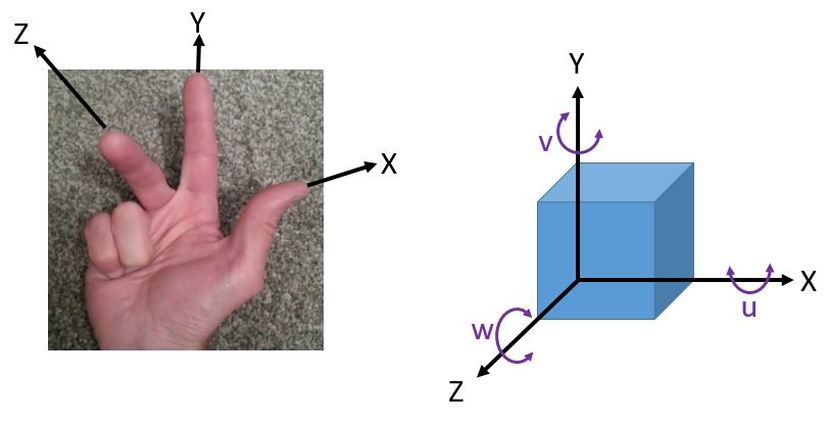Degrees Of Freedom
Every part can move in six different ways.
The first three are easy to understand. It can move side to side in the X direction as shown below, it can move up and down in the Y direction as shown below, and it can move in and out of the page in the Z direction as shown below.
A part can also rotate around the X axis. This degree of freedom is commonly referred to as "u". A part can also rotate around the Y axis. This degree of freedom is commonly referred to as "v". A part can also rotate around the Z axis. This degree of freedom is commonly referred to as "w".
The coordinate system shown below is called the "right hand coordinate system." We always use a right hand coordinate system. The X, Y, and Z axis are easy to remember if you arrange the fingers on your right hand as shown in the picture on the left. Your thumb is X, your trigger finger is Y, and your middle finger is Z.
Just be careful how you are holding your hand relative to other people so that you don't send any unintended messages.
The first three are easy to understand. It can move side to side in the X direction as shown below, it can move up and down in the Y direction as shown below, and it can move in and out of the page in the Z direction as shown below.
A part can also rotate around the X axis. This degree of freedom is commonly referred to as "u". A part can also rotate around the Y axis. This degree of freedom is commonly referred to as "v". A part can also rotate around the Z axis. This degree of freedom is commonly referred to as "w".
The coordinate system shown below is called the "right hand coordinate system." We always use a right hand coordinate system. The X, Y, and Z axis are easy to remember if you arrange the fingers on your right hand as shown in the picture on the left. Your thumb is X, your trigger finger is Y, and your middle finger is Z.
Just be careful how you are holding your hand relative to other people so that you don't send any unintended messages.
When we talk about datums, we will frequently refer to restraining the six degrees of freedom. That's just another way of saying that when we measure a part we first want to hold it still. So we must stop it from moving in each of these six ways.

